How to Choose the Fiber Optical Solution for Cisco Catalyst 4500-X Series Switch?
četvrtak , 08.12.2016.We can’t deny the fact that Cisco is one of the most important developers of network devices in the world. They supply a full range of switches including the Nexus, ME, Meraki, Blade, and Catalyst lines. Each of them is designed for unique applications, for example, Catalyst Switches is made for Campus Networks and Nexus Switches for Data Centers. Catalyst 4500-X series switch as one of the intriguing new switch of the catalyst lines, is a cost-effective, fixed aggregation for campus LAN network that brings in 10GbE uplinks. Featured with small size, high scale, this switch is warmly welcomed by overall users. Today’s article will provide some detailed information about this switch, and some advice about how to choose the right optical solutions.
Features of Catalyst 4500-X Series
Catalyst 4500-X switch is available in four versions: 40-port, 32-port, 16-port, and 8-port. Cisco offers seven different chassis of the series, namely Catalyst 4500X-16, Catalyst 4500X-24-IPB, Catalyst 4500X-24-ES, Catalyst 4500X-32, Catalyst 4500X-40, Catalyst 4500X-F-16, Catalyst 4500X-F-32. Remember to pick the right one that meets your needs. Compared with the Catalyst 3850 switch (also known as the 3750-X successor), we can clearly see its advantages, which has been displayed in the below part.
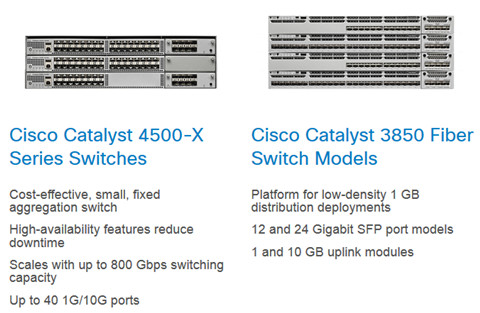
- Cisco Digital Network Architecture
Only Cisco delivers a digital-ready approach that starts at the edge and extends to where applications reside.
- Platform scalability
The Cisco 4500 offers up to 800 Gbps of switching capacity. It can scale up to 1.6-Tbps capacity and provides resiliency with Virtual Switching System (VSS). VSS refers to a method that can combine two physical switches into one logical switch to achieve physical redundancy, spanning free blocking elimination and increased bandwidth. That means any two Cisco catalyst 4500-X series switch can be pooled together into a VSS.
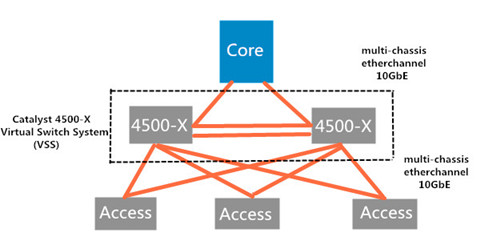
- High availability
Simplify network deployment and management with easy virtual networks (EVN). The 4500-X also reduces energy costs. Furthermore, device resiliency features such as redundant hot-swappable fans, power supplies, and AC to DC failover and vice versa remove single points of failure in the network.
- Application monitoring
Get enhanced application monitoring through Flexible NetFlow and 8 ports of line rate bidirectional Switched Port Analyzer (SPAN)/Remote Switched Port Analyzer (RSPAN). Cisco IOS XE Software provides the ability to host third-party applications.
- Security
Enhance security with support for Cisco TrustSec and Flexible NetFlow technologies.
- Simplified operations
The 4500-X offers support for Smart Install Director. Customers gain a single point of management for zero-touch deployment of new switches and stacks in campus and branch networks.
How to Choose the Optical Solutions for Catalyst 4500-X?
As noted before, the 4500-X ports support both SFP+ 10GbE optics and 1GbE modules. No matter what type of Catalyst 4500-X series switch you use, you will face the same problem of how to select the right one. The following image shows a 32-port chassis catalyst 4500-X series switch (front view).

1—UID LED and switch combination
2—STATUS LED
3—PS1 LED
4—PS2 LED
5—FAN LED
6—USB ports
7—The 16 port version of the chassis does not have the block of 16 ports on the right side of the front panel.
8—Port status LEDs
9—8-port uplink module (Included as part of the WS-C4500X-24ES and WS-C4500X-40ES chassis; available as an optional upgrade on the other Catalyst 4500-X series chassis)
As noted before, each Ethernet port requires either an SFP or SFP+ transceiver be installed to operate. The common used pluggable modules includes the three types—copper cable with RJ45 connector, direct attached cable and the pluggable transceiver module with the fiber patch cable. Before making the move, it is necessary for us to review the basic knowledge of the fiber optic transceiver (SFP and SFP+), DAC cables and fiber patch cable that are available for Catalyst 4500-X switch.
Cisco SFP and SFP+ Optical Transceivers
Fiber optic transceiver is a device that comprises of both a transmitter and receiver of analog or digital signals. It is usually inserted into optical devices like switch, router or network interface cards which provide one or more transceiver module slot. Cisco SFP modules and SFP+ optical transceivers are available in different standard. The following table has listed some of them, which you might want to have a look at it.
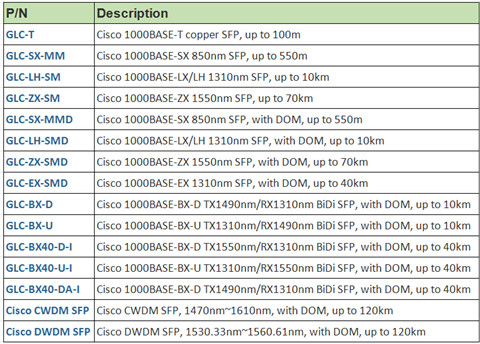
Figure 4 shows available Cisco SFPs for Catalyst 4500-X Series Switch
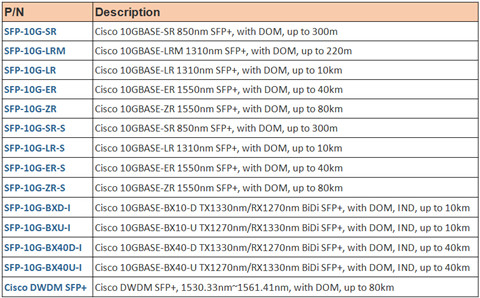
Figure 5 shows available Cisco SFP+ for Catalyst 4500-X Series Switch
Fiber Optic Patch Cables
Fiber Patch Cable, also known as fiber jumper or fiber optic patch cord is designed to interconnect or cross connect fiber networks within structured cabling systems. According to fiber cable mode, cable structure or connector types etc., fiber patch cable can be divided into different types. But remember that your fiber patch cables should always be compliant with the existing optical transceivers. For instance, LC LC multimode patch cord can be only used on the multimode optical transceivers (1000BASE-SR SFP or 10GBASE-SR SFP+). If you know nothing about this, it is advisable for you to talk with your supplier.
SFP+ Cables
SFP+ cables is the cost-effective solution for users in telecom field. It usually comes in DAC and AOC cable types. This fiber optical solution is suitable for short link applications within racks and across adjacent racks. Compared with the optical transceivers based system, it is inexpensive and more convenient. The available SFP+ cables are listed in the below chart.
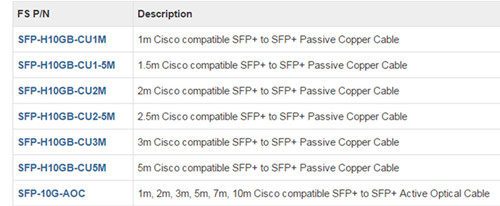
Fiberstore Fiber Optic Transceivers & Fiber Patch Cable Solutions
To sum up, in order to find the perfect fiber optic solution for your network, firstly you need to understand your needs, and consult with your vendors, then purchase all the available equipment within the budget. All the above optical devices like the copper cable, fiber optic cables, SFP & SFP+, and SFP+ DAC cables are provided at Fiberstore. You don’t need to worry about the compatibility issue because all of our products are tested in our test center before shipping. Furthermore, they are even backed by a lifetime warranty. Custom service is also available to fit your specific requirement.
Oznake: Cisco 4500, Cisco SFP modules
komentiraj (0) * ispiši * #
Choosing a Fiber Switch
srijeda , 02.11.2016.Do you have the experience of setting up a fiber switch for your network system? Or do you feel distressed for choosing an ideal fiber switch for you clients? Fiber switch is the dispensable telecom device that joins multiple devices within one network. There are many factors to be considered before you make a product choice. One of the key points is that fiber switch must accommodate severs and storage devices both for the present and future proof. Today’s article has concluded the frequently asked questions about selecting a fiber switch, and provide some assistance to you.
Fiber Switch Overview
Before we come to the main part, let’s have a brief overview of the fiber switches. Generally, fiber switch is broadly divided into two main category—modular and fixed configuration. The modular fiber switch just like the Cisco 4500 series switch (seen in the below image), allows you to add expansion modules into switched as needed, thereby delivering the best flexibility to address changing networks.

While the fixed configuration fiber switch, as the name implies, are switches with fixed number of ports and are typically not expandable. Cisco Catalyst 3750 is the good example of this. The fixed configuration switch category is further broken down into: unmanaged switch, smart switch and managed L2 and L3 switch. Each of them can be used in different situation.
How to Choose a Fiber Switch?
In the previous article entitled “Why Choose to Use a Managed Ethernet Switch?”, it mentioned the reasons why people should use managed switch other than unmamaged switch. Mangaed switch can give you better control over LAN traffic and offer advanced features like remote management, Redundancy, QoS services. Besides the above factors, some common features about choosing a right fiber switch is listed below.
Transmission Speed
Fiber switches are typically in Fast Ethernet, Gigabit Ethernet, 10 Gigabit and even 40/100 Gbps speeds. These switches have a number of uplink ports and downlink ports. Downlinks connect to end users, and uplinks connect to other Switches or to the network infrastructure. Currently, Gigabit speed is the most popular interface speed though Fast Ethernet is still widely used, especially in price-sensitive environments. 10 Gigabit has been growing rapidly, especially in the data center and, as the cost comes down, it will continue to expand into more network applications. And the 40G/100G is still emerging and will be mainstream in a few years. For example, the commonly used Catalyst 3750 is armed with 48 Ethernet 10/100/1000 ports with IEEE 802.3af PoE and 4 SFP uplinks, which is suitable for 1G application.
Number of Ports
Fiber switches typically come in 5, 8, 10, 16, 24, 28, 48, and 52-port configurations. These ports may be a combination of SFP/SFP+ slots for fiber connectivity, but more commonly they are copper ports with RJ-45 connectors on the front, allowing for distances up to 100 meters.
PoE Versus Non-PoE
Power over Ethernet (PoE) is a capability that facilitates powering a device (such as an IP phone, IP Surveillance Camera, or Wireless Access Point) over the same cable as the data traffic. One of the advantages of PoE is the flexibility it provides in allowing you to easily place endpoints anywhere in the business, even places where it might be difficult to run a power outlet.
However, switches have a power budget set aside for running the switch itself, and also an amount of power dedicated for PoE endpoints. For example, PoE switches according to 802.3af standard deliver power up to 15.4 Watts on a switch port, and IEEE 802.3at (also known as PoE+) delivers power up to 30 Watts on a switch port. For most endpoints, 802.3af is sufficient but there are devices, such as Video phones or Access Points with multiple radios, which have higher power needs. It’s important to point out that there are other PoE standards currently being developed that will deliver even high levels of power for future applications.
Whether to choose a PoE switch or non-PoE switch, you need to consider the features associated with the PoE capacity as well as your power needs. When connecting to desktops or other types of devices which do not require PoE, the non-PoE switches are a more cost-effective option.
Conclusion
When you are preparing a new installation with Fiber running, choose a suitable switch is essential. But if you search on the internet, you will find there are many types of switches on the market. Take Cisco as an example, it had launched a series of switches, and each has different performance. I hope this article can provide you some steep learning curve about fiber switches. It is advisable for you to ask an expert for help, or you may waste your money.
Oznake: Fiber switch, Cisco 4500, Catalyst 3750
komentiraj (0) * ispiši * #
